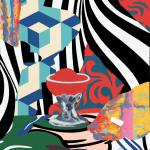Speedy Graphito French, b. 1961
31 7/8 x 25 5/8 in
In this artwork by Speedy Graphito titled Manet, there are several references to classical masters and movements, which contribute to its layered, neo-historical style. Here are some of the notable influences:
Édouard Manet: The central element of the bowl and the hand holding it likely references Manet’s still-life and figure compositions, especially his works featuring carefully arranged objects. Manet's influence is also visible in the simplified yet bold representation, echoing his unique approach to form and composition in the late 19th century.
Victor Vasarely and Op Art: The geometric patterns, particularly in the background with the blue and white cubes, are reminiscent of Vasarely’s work in Op Art. Vasarely’s style used optical illusions and geometric shapes to create a sense of depth and movement, which is reinterpreted here in a modern context.
Henri Matisse: The use of vibrant red and decorative motifs in the background also recalls Matisse’s influence, specifically his focus on ornamental patterns and his use of vivid, saturated colors that create a rich, decorative effect.
Cubism: The fragmentation and abstraction of forms reflect elements of Cubism, pioneered by artists like Pablo Picasso and Georges Braque. The layered, deconstructed approach adds a sense of dynamism and perspective that challenges traditional representation.
Abstract Expressionism: The brushstroke patterns and splashes of color on the right side of the painting resemble techniques from Abstract Expressionism, which could be seen as a nod to artists like Jackson Pollock. This element adds a spontaneous, expressive quality that contrasts with the structured geometry of Vasarely’s influence.
In blending these references, Speedy Graphito creates a visually engaging work that dialogues with past art movements while presenting them through a contemporary lens. The artwork becomes a dynamic interplay between tradition and innovation, highlighting Speedy Graphito’s ability to merge iconic historical elements with his distinct, modern style.
Exhibitions
« Neo History » ART FIVE Gallery Marseille




